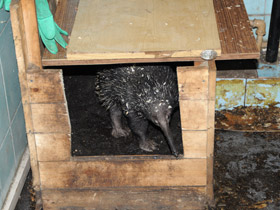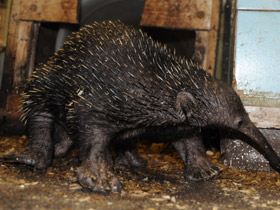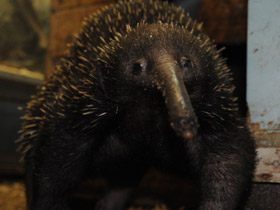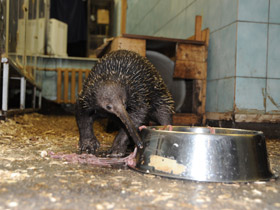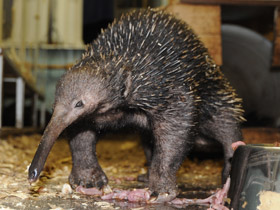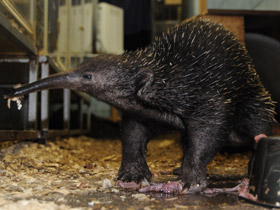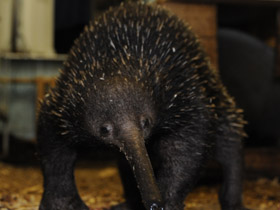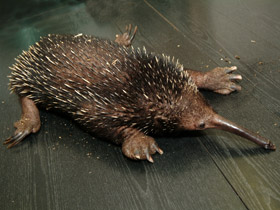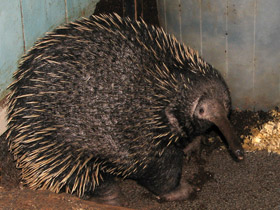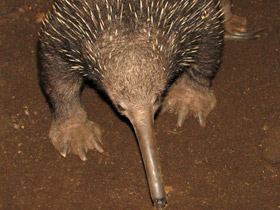The western long-beaked echidna (Zaglossus bruijnii)
The western long-beaked echidna (Zaglossus bruijnii) is one of the four extant echidnas and one of three species of Zaglossus that occurs in New Guinea. Originally described as Tachyglossus bruijnii, this is the type species of Zaglossus.
Appearance and peculiarities
Zaglossus bruijni is a species of monotreme mammal of the family Tachyglossidae native to New Guinea. It is the type species of the genus Zaglossus. Subfossils of this species are also found in northern Australia.
Zaglossus bruijni belongs to a small group of monotremes that are also known as oviparous mammals, as they are the only modern mammals that lay eggs. The structure of the bones of the skull and limb girdle, the structure of the eyes and the sense of smell are similar to those of reptiles, suggesting that they are ancient and primitive.
The massive body of this ancient animal is covered with thick, dark brown wool and has short needles 3-5 cm long on the back and sides. Larger than an ordinary echidna, Zaglossus bruijni is 77 cm long and weighs 5-10 kg. Its limbs are also much longer than those of echidnas, with well-developed muscles and powerful claws. The hind limbs are five-toed, while the forelimbs are three-toed (the first and fifth toes are reduced and resemble tubercles). The ear pinnae are very small and the short tail is 5-7 cm long. The front part of the head of Zaglossus bruijni is elongated into a long, strongly downward curved rostrum, which accounts for 2/3 of the length of the head; at its end are the nostrils (by the way, Zaglossus bruijni has an excellent sense of smell) and a small mouth. This "beak" is necessary for Zaglossus bruijni to find food, but it is also an extra strong and sticky limb, which allows it to overcome obstacles or as a lever for turning stones. The tongue of this amazing beast is very long (up to 30 cm) and covered with sharp spines, which compensate for the lack of teeth.
The primitive character of these oviparous beasts (or as they used to be called, "first beasts") is reinforced by their body temperature, which varies from 36 to 25°C, depending on the ambient temperature. Surprisingly, they remain active and only hibernate in the most unfavourable conditions.
Area habitat and nutrition
Zaglossus bruijni lives predominantly in the high mountain rainforests of north-western New Guinea, but can also be found in alpine meadows up to 4,000 m altitude. These ancient animals feed almost exclusively on earthworms, which they forage for by digging their beaks into the ground. When the Zaglossus bruijni smells a faint earthworm scent, it digs a hole with its nose and burrows into the soil until it finds a morsel. To remove the worm, it pierces it with the barbs of its tongue, then grabs the tip of the worm in its mouth and, actively helping itself with its tongue, drags it in, like spaghetti. Sometimes Zaglossus bruijni also eats termites, insect larvae and ants. They drink in a rather amusing way: they stick their noses in the water and suck it into their mouths, blowing bubbles.
Breeding
The breeding season of Zaglossus bruijni begins in July. After mating, the female lays one egg (according to other reports, 3-4), which she incubates in her pouch. After about ten days, a young hatches from the egg, which the female feeds with milk until it is 6 months old.
Conservation status
Zaglossus bruijni is very rare and is included in the IUCN Red List as a "critically endangered species".
Conservation
The species is listed as Critically Endangered by the IUCN; numbers have decreased due to human activities including habitat loss and hunting. The western long-beaked echidna is considered a delicacy, and although commercial hunting of the species has been banned by the Indonesian government, traditional hunting is permitted.









